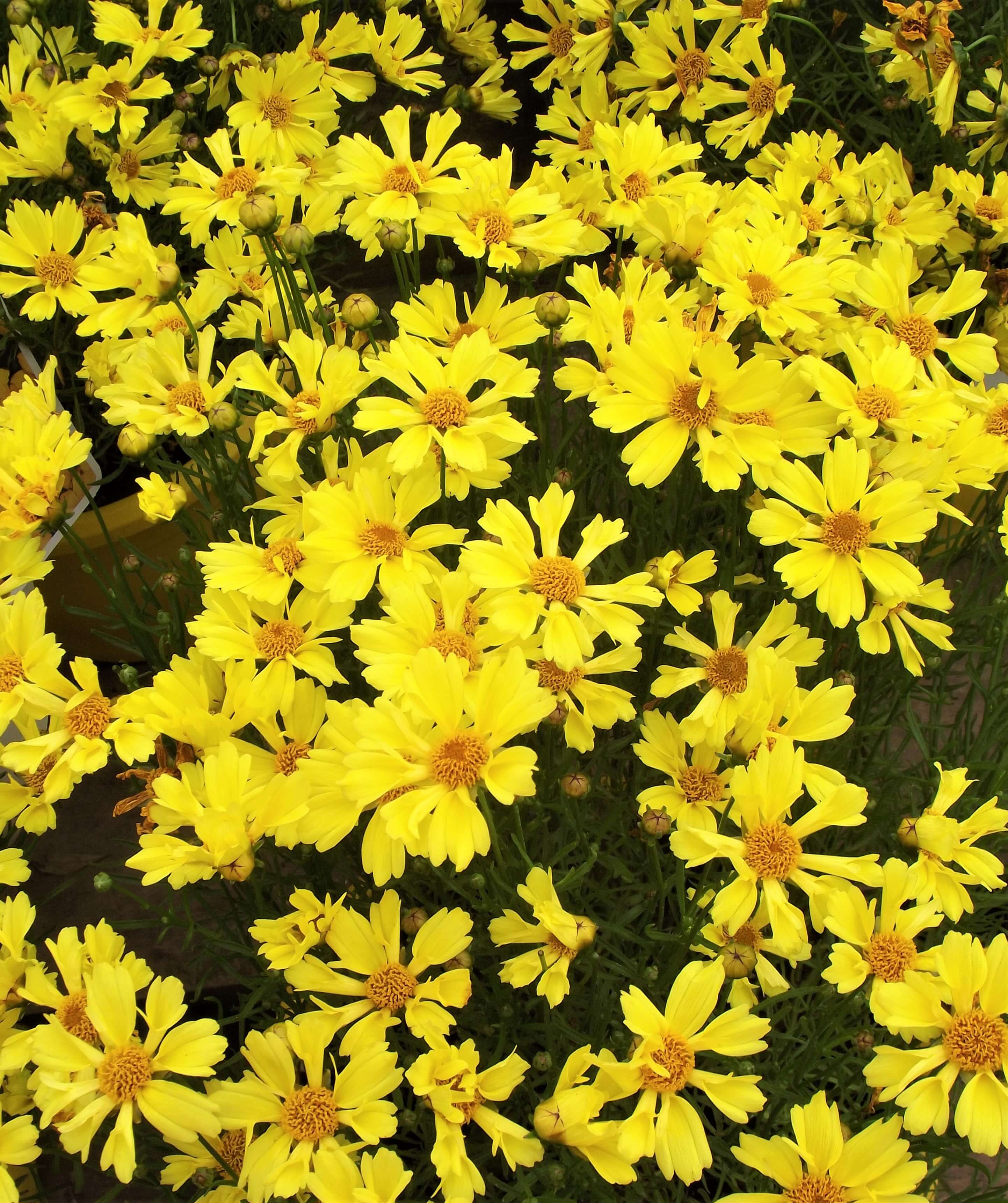The thing I like the most about Coreopsis is that it is unpretentious. There are no large flowers, flashy foliage, or excessively tall plants vying for your attention; instead, this decidedly blue-collar flora simply keeps its nose to the grindstone and fills our gardens with reliable colour for months on end, asking little in return, except to be divided from time to time. Since they generally come into bloom just about now, I thought I would share an overview of available species as well as the myriad of complex hybrids.
Thread-Leaf Coreopsis (Coreopsis verticillata)
These are by far my favourite Coreopsis, as the fine threadlike foliage combines well with other perennials, as does the yellow palette. ‘Zagreb’ with its bright chrome-yellow blooms (June to September) is a better choice than the floppier ‘Golden Showers’ (larger flowers), and combines beautifully with ‘Hidcote’ lavender or Pennisetum orientale. We had a clump of this in the nursery garden that thrived for over 20 years with no division and just one fertilization each April. ‘Moonbeam’ was the 1992 perennial plant of the year and with its pale-yellow daisies is considered a universal blender, as it works well in both hot and cool colour schemes. I would give these a light shearing when they go to seed midsummer in order to promote a longer flowering season. Zone 3.
Pink Tickseed (Coreopsis rosea)
This species has the same fine foliage as C. verticillata but spreads more readily, so I would consider using it as a foreground groundcover. The most common cultivar is ‘American Dream’ which bears single rose-pink daisies from June to August on compact foliage (8-12”). The less-common ‘Heaven’s Gate’ has larger pink blooms inset with ruby centers and was found as a sport of ‘Sweet Dreams’. These also benefit from a midsummer shearing to remove the seed heads and extend the flowering season. Zone 4.
Mouse-Ear Coreopsis (Coreopsis auriculata)

The least common of the Coreopsis is usually represented by ‘Nana’, a dwarf cultivar that much resembles C. grandiflora but only grows 10-12” tall. It flowers from May to June, although deadheading will prolong the blooming season. Much more interesting are the cultivars ‘Zamphir’ and ‘Jethro Tull’ (a hybrid) which feature golden-yellow flowers with unique fluted or tubular petals. Zone 5.
(Image: 'Zamphir')
Large-Flowered Tickseed (Coreopsis grandiflora)
Many gardeners have a hard time overwintering this species, as young plants are so floriferous that they tend to die off in winter. The key here is to remove all new flowers starting mid-September, allowing plants to conserve their energy for foliage and root production, rather than letting them "bloom to death." The large golden-yellow blossoms are highly sought after by pollinators and butterflies, and there are both single and double-flowered forms. ‘Baby Sun’ brings us compact growth with large 2” blooms, while the ever-popular ‘Early Sunrise’ bears taller semi-double flowers. The variegated ‘Tequila Sunrise’ (a hybrid) bears golden-yellow blooms with a ruby eye over cream-edged foliage and the newer ‘SunKiss’ provides us with larger (3” wide) bright yellow flowers sharply contrasted by a pronounced burgundy-red centre. All make great cut flowers. Zone 4.
Hybrids (Coreopsis x)
Here is where the colour palette really begins to expand into burgundy, true reds, coral, orange, and pale-yellow blooms. At the intense end of the spectrum are ‘Hot Paprika’ (deep red), as well as the tender ‘Cherry Lemonade’ (Zone 9) which really pops with burgundy daisies sharply contrasted by feathery golden foliage. ‘Mercury Rising’ veers into dark red territory, while ‘Bengal Tiger’ adds a splash of pale yellow at the petal edges. ‘Desert Coral’ (coral-red with peach tips) and ‘Sunstar Orange’ (orange with a prominent red eye) look right at home with Rudbeckia and Red-Hot Pokers (Kniphofia) in mixed borders with hot colours, as does the eye-catching ‘Route 66’ (golden-yellow with a red eye) and ‘COLOROPSIS Salsa’ (burgundy-red with sharply contrasting bright yellow tips). ‘Crème Brulee’ has slightly darker pale-yellow blooms than its parent ‘Moonbeam,' but that unique hue invites its use in just about any colour scheme. Zones 4-9 depending on the cultivar.
So, for gardeners looking for long-lasting perennial flowers in a multitude of colours, you need to look no further than Coreopsis for that perfect plant combination.


